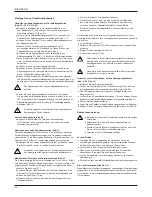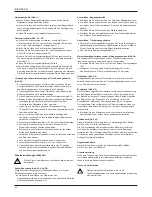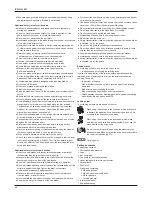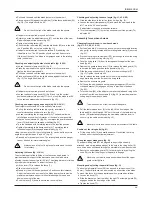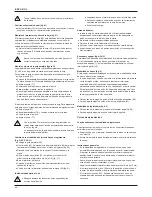
31
E N G L I S H
Safety instructions
When using stationary power tools, always observe the safety
regulations applicable in your country to reduce the risk of fi re,
electric shock and personal injury.
Read all of this manual carefully before operating the tool.
Save this manual for future reference.
General
1 Keep work area clean
Cluttered areas and benches can cause accidents.
2 Consider work area environment
Do not expose the tool to rain. Do not use the tool in damp or wet
conditions. Keep the work area well lit (250 - 300 Lux). Do not use
the tool where there is a risk of causing fi re or explosion, e.g. in the
presence of fl ammable liquids and gases.
3 Keep children away
Do not allow children, visitors or animals to come near the work area
or to touch the tool or the mains cable.
4 Dress properly
Do not wear loose clothing or jewellery, as these can be caught in
moving parts. Wear protective hair covering to keep long hair out of
the way. When working outdoors, preferably wear suitable gloves
and non-slip footwear.
5 Personal protection
Always use safety glasses. Use a face or dust mask whenever the
operations may produce dust or fl ying particles. If these particles
might be considerably hot, also wear a heat-resistant apron.
Wear ear protection at all times. Wear a safety helmet at all times.
6 Guard against electric shock
Prevent body contact with earthed or grounded surfaces (e.g. pipes,
radiators, cookers and refrigerators). When using the tool under
extreme conditions (e.g. high humidity, when metal swarf is being
produced, etc.), electric safety can be improved by inserting an
isolating transformer or a (FI) earth-leakage circuit-breaker.
7 Do not overreach
Keep proper footing and balance at all times.
8 Stay alert
Watch what you are doing. Use common sense. Do not operate the
tool when you are tired.
9 Secure workpiece
Use clamps or a vice to hold the workpiece. It is safer and it frees
both hands to operate the tool.
10 Connect dust extraction equipment
If devices are provided for the connection of dust extraction and
collection facilities, ensure that these are connected and properly used.
11 Remove adjusting keys and wrenches
Always check that adjusting keys and wrenches are removed from
the tool before operating the tool.
12 Extension cables
Before use, inspect the extension cable and replace if damaged.
When using the tool outdoors, only use extension cables intended for
outdoor use and marked accordingly.
13 Use appropriate tool
The intended use is described in this instruction manual. Do not force
small tools or attachments to do the job of a heavy-duty tool. The tool
will do the job better and safer at the rate for which it was intended.
Do not force the tool.
Warning!
The use of any accessory or attachment or performance
of any operation with this tool other than those recommended in this
instruction manual may present a risk of personal injury.
14 Check for damaged parts
Before use, carefully check the tool and mains cable for damage.
Check for misalignment and seizure of moving parts, breakage of
parts, damage to guards and switches and any other conditions that
may affect its operation.
Ensure that the tool will operate properly and perform its intended
function. Do not use the tool if any part is damaged or defective.
Do not use the tool if the switch does not turn it on and off.
Have any damaged or defective parts replaced by an authorised
D
E
WALT repair agent. Never attempt any repairs yourself.
15 Unplug tool
Switch off and wait for the tool to come to a complete standstill
before leaving it unattended. Unplug the tool when not in use, before
changing any parts of the tools, accessories or attachments and
before servicing.
16 Avoid unintentional starting
Be sure that the tool is switched off before plugging in.
17 Do not abuse cord
Never pull the cord to disconnect from the socket. Keep the cord
away from heat, oil and sharp edges.
18 Store idle tools
When not in use, tools must be stored in a dry place and locked up
securely, out of reach of children.
19 Maintain tools with care
Keep the tools in good condition and clean for better and safer
performance. Follow the instructions for maintenance and changing
accessories. Keep all handles and switches dry, clean and free from
oil and grease.
20 Repairs
This tool is in accordance with the relevant safety regulations. Have
your tool repaired by an authorised D
E
WALT repair agent. Repairs
should only be carried out by qualifi ed persons using original spare
parts; otherwise this may result in considerable danger to the user.
Additional safety rules for fl ip-over saws
● Do not allow untrained people to operate this machine.
● Do not use the saw to cut other than aluminium, wood or similar
materials.
● Connect the machine to a dust collection device when sawing wood.
● Select the correct saw blade for the material to be cut.
● Do not use cracked or damaged saw blades.
● Do not use HSS blades.
● Use correctly sharpened blades. Observe the maximum speed
marked on the saw blade.
● Use only saw blades recommended by the manufacturer and which
conform to EN 847-1.
● Do not use the saw without the guards and riving knife in position
and properly maintained, especially when changing from mitre saw
mode to bench saw mode, or vice versa.
● Make sure the fl oor area around the machine is level, well
maintained and free of loose materials, e.g. chips and cut-offs.
● Make sure adequate general or localized lighting is provided.
● Wear suitable personal protective equipment when necessary,
including:
– hearing protection to reduce the risk of induced hearing loss;
– respiratory protection to reduce the risk of inhalation of harmful dust;
– gloves for handling saw blades and rough material. Saw blades
should be carried in a holder wherever practicable.
● Refrain from removing any cut-offs or other parts of the work piece
from the cutting area while the saw is running and the saw head is
not in the rest position.
● Replace the table insert when worn.
● Report faults in the machine, including guards or saw blades, to your
dealer as soon as they are discovered.
● Ensure that the upper portion of the saw blade is completely
enclosed in the mitre sawing mode.
● Ensure that the arm is securely fi xed in the working position in the
bench sawing mode.
● Ensure that the arm is securely fi xed when bevelling in the bench
saw mode.
Summary of Contents for DW743
Page 1: ...DW743 ...
Page 3: ...3 3 A2 A1 10 11 8 7 14 13 12 5 6 4 3 2 9 1 21 19 20 18 14 15 16 22 17 ...
Page 4: ...4 4 A4 A5 A3 27 24 25 26 23 22 29 28 34 30 31 33 32 35 ...
Page 5: ...5 5 A8 B A6 A7 29 36 37 38 X ...
Page 6: ...6 6 C1 E1 D C2 E2 47 48 49 18 46 52 51 53 54 50 20 2 55 56 23 ...
Page 8: ...8 8 J2 J1 K1 K2 L1 L2 M N 7 72 74 22 73 75 16 12 76 77 2 20 3 8 mm 62 16 16 25 76 ...
Page 9: ...9 9 O P Q R S T U 77 78 26 79 80 81 V1 82 81 ...
Page 10: ...10 10 V3 W 84 83 85 85 V2 ...
Page 137: ...137 ...
Page 138: ...138 ...
Page 139: ...139 ...










